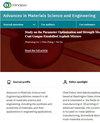Low Dark Current Mesa-Type AlGaN Flame Detectors
4区 材料科学
Q2 Engineering
引用次数: 0
Abstract
This study characterizes and reports on the fabrication process of AlGaN flame photodetectors with an Al0.1Ga0.9N/GaN superlattice structure. The AlGaN flame photodetectors exhibited a low dark current (∼1.17×10−10 A at bias of −5 V) and large rejection ratio of photocurrent (∼2.14×10−5 A at bias of -5 V) to dark current, which is greater than five orders of magnitude. Responsivity at 350 nm at a bias of -5 V was 0.194 A/W. Quantum efficiency, η, was 0.687 at a reverse bias of 5 V.低暗电流台面型海藻火焰探测器
本文研究并报道了Al0.1Ga0.9N/GaN超晶格结构的AlGaN火焰光电探测器的制备过程。AlGaN火焰光电探测器具有较低的暗电流(−1.17×10−10 a,偏置为−5 V)和较大的光电流(−2.14×10−5 a,偏置为-5 V)对暗电流的抑制比,大于5个数量级。在-5 V偏置下,350 nm处的响应度为0.194 a /W。在反向偏置5 V时,量子效率η为0.687。
本文章由计算机程序翻译,如有差异,请以英文原文为准。
求助全文
约1分钟内获得全文
求助全文
来源期刊

Advances in Materials Science and Engineering
Materials Science-General Materials Science
CiteScore
3.30
自引率
0.00%
发文量
0
审稿时长
4-8 weeks
期刊介绍:
Advances in Materials Science and Engineering is a broad scope journal that publishes articles in all areas of materials science and engineering including, but not limited to:
-Chemistry and fundamental properties of matter
-Material synthesis, fabrication, manufacture, and processing
-Magnetic, electrical, thermal, and optical properties of materials
-Strength, durability, and mechanical behaviour of materials
-Consideration of materials in structural design, modelling, and engineering
-Green and renewable materials, and consideration of materials’ life cycles
-Materials in specialist applications (such as medicine, energy, aerospace, and nanotechnology)
 求助内容:
求助内容: 应助结果提醒方式:
应助结果提醒方式:


